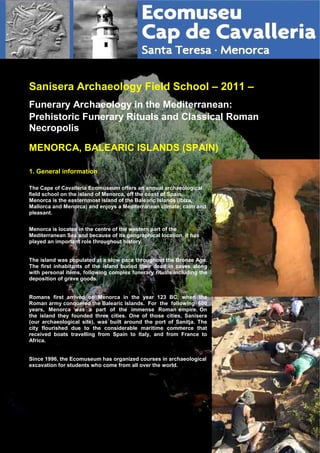
2011 Course: Funerary Archaeology in the Mediterranean: Prehistoric Funerary Rituals and Classical Roman Necropolis
- 1. Sanisera Archaeology Field School – 2011 – Funerary Archaeology in the Mediterranean: Prehistoric Funerary Rituals and Classical Roman Necropolis MENORCA, BALEARIC ISLANDS (SPAIN) 1. General information The Cape of Cavalleria Ecomuseum offers an annual archaeological field school on the island of Menorca, off the coast of Spain. Menorca is the easternmost island of the Balearic Islands (Ibiza, Mallorca and Menorca) and enjoys a Mediterranean climate; calm and pleasant. Menorca is located in the centre of the western part of the Mediterranean Sea and because of its geographical location, it has played an important role throughout history. The island was populated at a slow pace throughout the Bronze Age. The first inhabitants of the island buried their dead in caves along with personal items, following complex funerary rituals including the deposition of grave goods. Romans first arrived on Menorca in the year 123 BC, when the Roman army conquered the Balearic Islands. For the following 600 years, Menorca was a part of the immense Roman empire. On the island they founded three cities. One of those cities, Sanisera (our archaeological site), was built around the port of Sanitja. The city flourished due to the considerable maritime commerce that received boats travelling from Spain to Italy, and from France to Africa. Since 1996, the Ecomuseum has organized courses in archaeological excavation for students who come from all over the world.
- 2. 2. Course Description The Cape of Cavalleria Ecomuseum in Menorca, Spain, has scheduled for 2011, the excavation of two burial sites: The Roman Necropolis and the Prehistoric Cave. The students will be introduced to Mediterranean Physical Anthropology by excavating in these two sites: the prehistoric cave during the first half of the course, and the Roman Necropolis during the second half. The Roman Necropolis Dig involves the excavation of a cluster of roman tombs belonging to a cemetery located on the outskirts of the roman city of Sanisera, which was occupied from 123 BC to 550 AD. The Prehistoric Cave Dig is focused on the excavation of funerary deposits made by the first inhabitants of Menorca. The dig takes place in a cave known as “Cueva de la Costa Norte”, very close to the Cape of Cavalleria Ecomuseum. It is a collective burial site which dates between 2000 and 1350 B.C. It involves the collection of burnt bone samples, pottery vessels, bronze and bone pendants and beads, among other artifacts. The excavation is directed by Fernando Contreras, director of the Ecomuseum of the Cape of Cavalleria in collaboration with other archaeologists and specialists in physical anthropology and conservation. The course runs 7 hours per day, with time dedicated to both excavation and laboratory work. The course is divided into two halves: the Roman Necropolis Dig and the Prehistoric Cave Dig. The excavation of the Necropolis focuses on funerary structures, specifically inhumations, while the Prehistoric Cave focuses on the spatial distribution of the remains and the objects and grave goods related to funerary rituals. Participants will learn and apply excavation techniques used in physical anthropology when excavating. In the laboratory participants will be instructed by an anthropologist and other specialists in the classification, study, and conservation of human remains and other related materials found. Participants will also be given lectures on methodology, Roman archaeology, physical anthropology and classification of archaeological materials. Participants will visit other archaeological sites on the island through organized excursions. Courses are given in both English and Spanish. For every seven course days there are two days off.
- 3. 3. Certificates At the end of the course, students will receive a certificate of participation stating the hours and activities of the course. Participants that perform exceedingly well in the course may receive a letter of recommendation from our organization up on request. 4. Directed at The course is open to any individual that would like to learn about archaeology. Although, we do recommend a strong interest in physical anthropology, previous knowledge or experience is not required. 5. Session Dates and Costs 10 Sessions (20 days each): Session #1: March 29th – April 17th $ 2500 Session #2: April 20th – May 9th $ 1500 Session #3: May 12th – May 31st $ 2500 Session #4: June 3rd – June 22nd $ 2500 Session #5: June 25th – July 14th $ 2500 Session #6: July 17th – August 5th $ 2500 Session #7: August 8th – August 27th $ 2500 Session #8: August 30th – September 18th $ 1800 Session #9: September 20th – October 9th $ 1800 Session #10: October 12th – October 31st $ 1800 Course fee includes: • Course tuition. • Accommodation in the Student Residency in Ciutadella. Two to six per room. Walking distance to the historic center, port and beaches. • Daily transportation to/from the excavation site. • Breakfast, lunch and dinner in Ciutadella. • Morning snack at the Ecomuseum. • Accident insurance at the site. • Excursions. • Certificate of participation. Airfare not included. 6. Spaces available The course is limited to 16 participants per session. Reservations are only effective when payment of the registration fee is received. If for any reason the course is cancelled, payment is returned according to the field school refund policy (see the Ecomuseum’s webpage, Archaeology Field School). 7. Information and reservations For more information, contact: archaeology@ecomuseodecavalleria.com Web page: www.ecomuseodecavalleria.com
